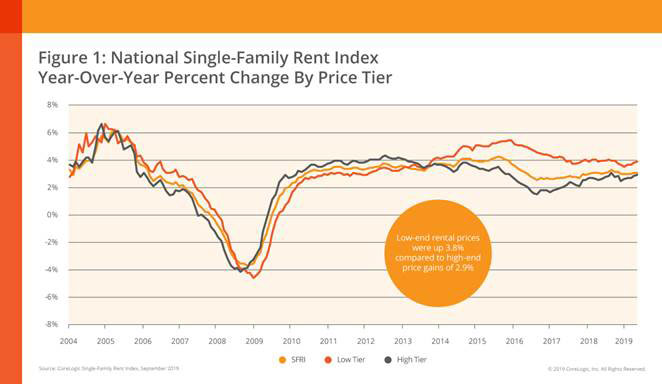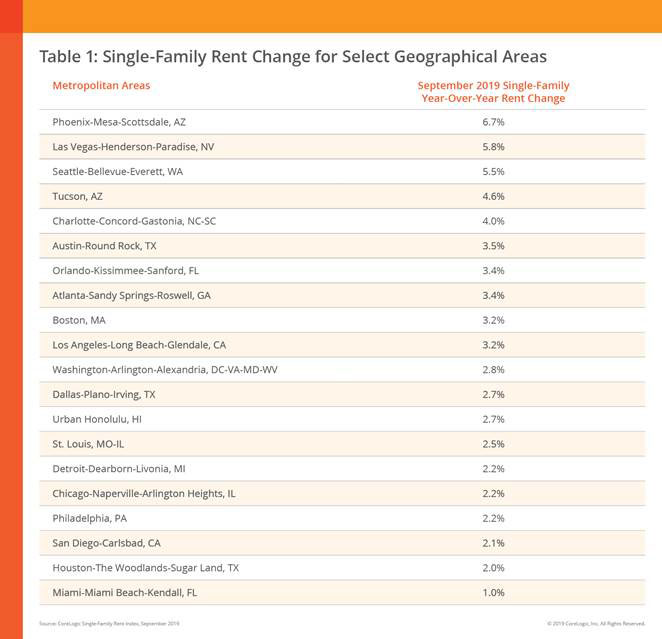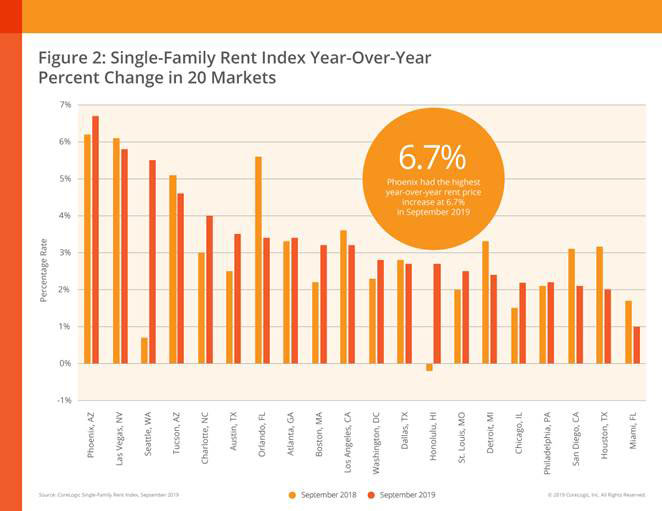The WPJ
THE WORLD PROPERTY JOURNALReal Estate Facts Not Fiction
Residential Real Estate News

Single-Family Rents Rise 3 Percent Annually in U.S.
Residential News » Irvine Edition | By WPJ Staff | November 26, 2019 8:00 AM ET
CoreLogic's newly released Single-Family Rent Index (SFRI) -- which analyzes single-family rent price changes nationally and among 20 U.S. metropolitan areas -- shows a national rent increase of 3 percent in September 2019, which remained flat in comparison to September 2018.
Low rental home inventory, relative to demand, fuels the growth of single-family rent prices. The SFRI shows single-family rent prices have climbed between 2010 and 2019. However, overall year-over-year rent price increases have slowed since February 2016, when they peaked at 4 percent, and have stabilized around 3 percent since early 2019.
September marked the 65th consecutive month in which low-end rentals propped up national rent growth. Rent prices among this tier, defined as properties with rent prices less than 75 percent of the regional median, increased 3.8 percent year over year in September 2019, the same as in September 2018. Meanwhile, high-end rentals, defined as properties with rent prices greater than 125 percent of a region's median rent, increased 2.9 percent in September 2019, up from a gain of 2.5 percent in September 2018.
Among the 20 metro areas shown in Table 1 below, and for the tenth consecutive month, Phoenix had the highest year-over-year increase in single-family rents in September 2019 at 6.7 percent (compared to September 2018), followed by Las Vegas at 5.8 percent. Seattle outpaced Tucson, Arizona, as the third-highest metro for rent growth in September with gains of 5.5 percent, while Miami experienced the lowest rent increases of all analyzed metros at 1 percent.
Metro areas with limited new construction, low rental vacancies and strong local economies that attract new employees tend to have stronger rent growth. Phoenix experienced high year-over-year rent growth in September, driven by the annual employment growth of 2.4 percent. This is compared with the national employment growth average of 1.4 percent, according to data from the United States Bureau of Labor Statistics. Seattle also experienced an elevated annual employment growth of 3.3 percent, which played a role in its above-average, year-over-year rent increase in September.
"Low rental supply coupled with ongoing demand pushed up rents in September," said Molly Boesel, principal economist at CoreLogic. "Vacancy rates have fallen moderately on the national level over the last quarter - with a 0.3 percent decrease in the third quarter of 2019 compared to a year earlier - and more significantly in select metro areas. Of the metros analyzed in the CoreLogic Single-Family Rent Index, Phoenix experienced the largest decrease in vacancy rates at 2.6 percent, which helped drive its rent growth to the top of the nation in September."

Low rental home inventory, relative to demand, fuels the growth of single-family rent prices. The SFRI shows single-family rent prices have climbed between 2010 and 2019. However, overall year-over-year rent price increases have slowed since February 2016, when they peaked at 4 percent, and have stabilized around 3 percent since early 2019.
September marked the 65th consecutive month in which low-end rentals propped up national rent growth. Rent prices among this tier, defined as properties with rent prices less than 75 percent of the regional median, increased 3.8 percent year over year in September 2019, the same as in September 2018. Meanwhile, high-end rentals, defined as properties with rent prices greater than 125 percent of a region's median rent, increased 2.9 percent in September 2019, up from a gain of 2.5 percent in September 2018.
Among the 20 metro areas shown in Table 1 below, and for the tenth consecutive month, Phoenix had the highest year-over-year increase in single-family rents in September 2019 at 6.7 percent (compared to September 2018), followed by Las Vegas at 5.8 percent. Seattle outpaced Tucson, Arizona, as the third-highest metro for rent growth in September with gains of 5.5 percent, while Miami experienced the lowest rent increases of all analyzed metros at 1 percent.
Metro areas with limited new construction, low rental vacancies and strong local economies that attract new employees tend to have stronger rent growth. Phoenix experienced high year-over-year rent growth in September, driven by the annual employment growth of 2.4 percent. This is compared with the national employment growth average of 1.4 percent, according to data from the United States Bureau of Labor Statistics. Seattle also experienced an elevated annual employment growth of 3.3 percent, which played a role in its above-average, year-over-year rent increase in September.
"Low rental supply coupled with ongoing demand pushed up rents in September," said Molly Boesel, principal economist at CoreLogic. "Vacancy rates have fallen moderately on the national level over the last quarter - with a 0.3 percent decrease in the third quarter of 2019 compared to a year earlier - and more significantly in select metro areas. Of the metros analyzed in the CoreLogic Single-Family Rent Index, Phoenix experienced the largest decrease in vacancy rates at 2.6 percent, which helped drive its rent growth to the top of the nation in September."

Sign Up Free | The WPJ Weekly Newsletter
Relevant real estate news.
Actionable market intelligence.
Right to your inbox every week.
Real Estate Listings Showcase
Related News Stories
Residential Real Estate Headlines
- More Americans Opting for Renting Over Homeownership in 2024
- BLOCKTITLE Global Property Tokenization Platform Announced
- Small Investors Quietly Reshaping the U.S. Housing Market in Late 2024
- Greater Miami Overall Residential Sales Dip 9 Percent in November
- U.S. Home Sales Enjoy Largest Annual Increase in 3 Years Post Presidential Election
- U.S. Housing Industry Reacts to the Federal Reserve's Late 2024 Rate Cut
- U.S. Home Builders Express Optimism for 2025
- Older Americans More Likely to Buy Disaster-Prone Homes
- NAR's 10 Top U.S. Housing Markets for 2025 Revealed
- U.S. Mortgage Delinquencies Continue to Rise in September
- U.S. Mortgage Rates Tick Down in Early December
- Post Trump Election, U.S. Homebuyer Sentiment Hits 3-Year High in November
- Global Listings Aims to Become the Future 'Amazon of Real Estate' Shopping Platform
- Greater Las Vegas Home Sales Jump 15 Percent in November
- Ultra Luxury Home Sales Globally Experience Slowdown in Q3
- World Property Exchange Announces Development Plan
- Hong Kong Housing Market to Reach Equilibrium in Late 2025
- Construction Job Openings in U.S. Down 40 Percent Annually in October
- U.S. Mortgage Applications Increase in Late October
- World Property Markets, World Property Media to Commence Industry Joint-Venture Funding Rounds in 2025
- New Home Sales Hit 2 Year Low in America
- U.S. Pending Home Sales Increase for Third Consecutive Month in October
- Pandemic-led Residential Rent Boom is Now Fizzling in the U.S.
- Emerging Global Real Estate Streamer WPC TV Expands Video Programming Lineup
- 1 in 5 Renters in America Entire Paycheck Used to Pay Monthly Rent in 2024
- U.S. Home Sales Jump 3.4 Percent in October
- Home Buyers Negotiation Power Grows Amid Cooling U.S. Market
- Canadian Home Sales Surge in October, Reaching a Two-Year High
- Greater Orlando Area Home Sales Continue to Slide in October
- U.S. Mortgage Credit Availability Increased in October
- U.S. Mortgage Rates Remain Stubbornly High Post Election, Rate Cuts
- Construction Input Prices Continue to Rise in October
- BETTER MLS: A New Agent and Broker Owned National Listings Platform Announced
- Home Prices Rise in 87 Percent of U.S. Metros in Q3
- Caribbean Islands Enjoying a New Era of Luxury Property Developments
- The World's First 'Global Listings Service' Announced
- Agent Commission Rates Continue to Slip Post NAR Settlement
- Market Share of First Time Home Buyers Hit Historic Low in U.S.
- Greater Palm Beach Area Residential Sales Drop 20 Percent Annually in September
- Mortgage Applications in U.S. Dip in Late October
Reader Poll
Marketplace Links
This website uses cookies to improve user experience. By using our website you consent in accordance with our Cookie Policy. Read More







